Articulation #5 – Tenuto
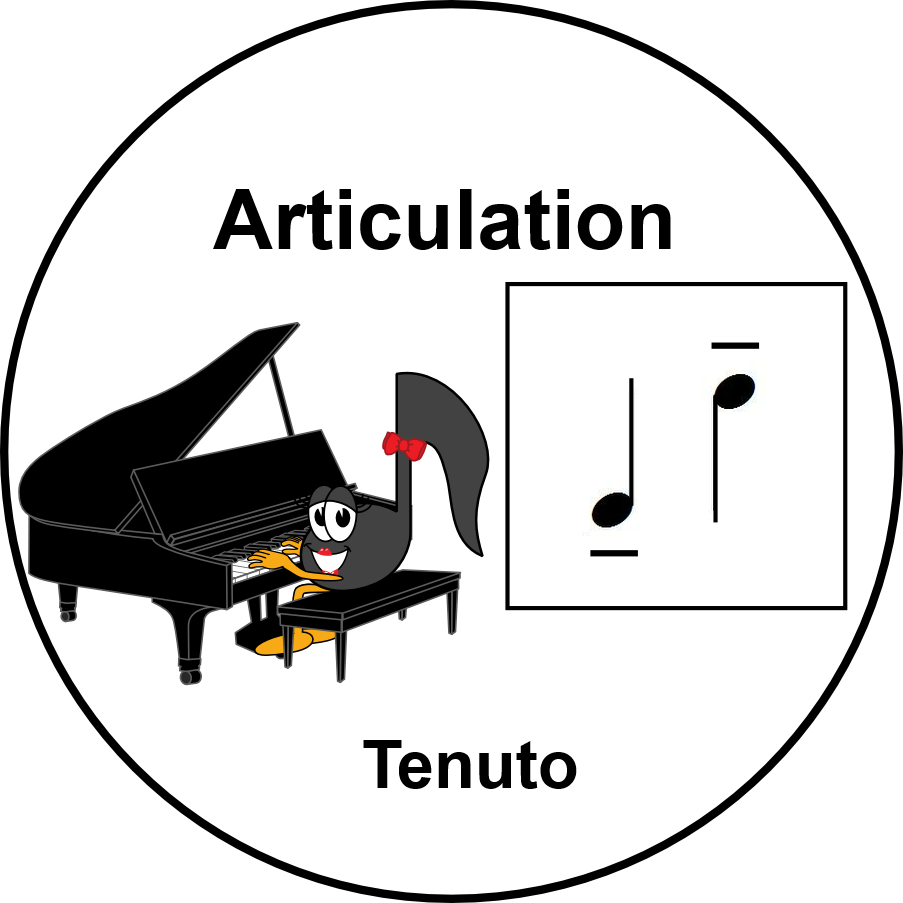
Articulation Signs tell us how to play a note. The Essential Dictionary of Music defines Articulation as "the manner in which notes are performed, such as staccato or legato".
In our Articulation Blog Series, we have explored:
- Articulation Blog Series #1 - Accent
- Articulation Blog Series #2 - Staccato
- Articulation Blog Series #3 - Staccatissimo
- Articulation Blog Series #4 - Marcato
In this blog, we will look at the Tenuto.
The term "Tenuto" means "held, sustained". So how do you tell that a note is to be played Tenuto?
In this Blog, we are going to explore the Tenuto Sign (Tenuto Mark) - the Articulation Sign that tells us what notes are to be played held, or sustained.
Articulation - Tenuto - Spot the Boo-Boo
Yes, it is Mme. Shelagh's favourite way to start a Blog - a Spot the Boo-Boo Challenge!
Please look through this picture. Can you tell which Tenuto Lines have been written correctly and which are incorrect? How confident are you of the reasons behind each answer?
PS - I teach in Brockville, Ontario, Canada. I have a lot of French Students, so "Mme. Shelagh" is pronounced as "Madame Shelagh" (Shelagh = Sheila, just the Gaelic spelling). Although I do not speak fluent French, I can speak a super "Fran-glais" (French/English hybrid) while teaching!
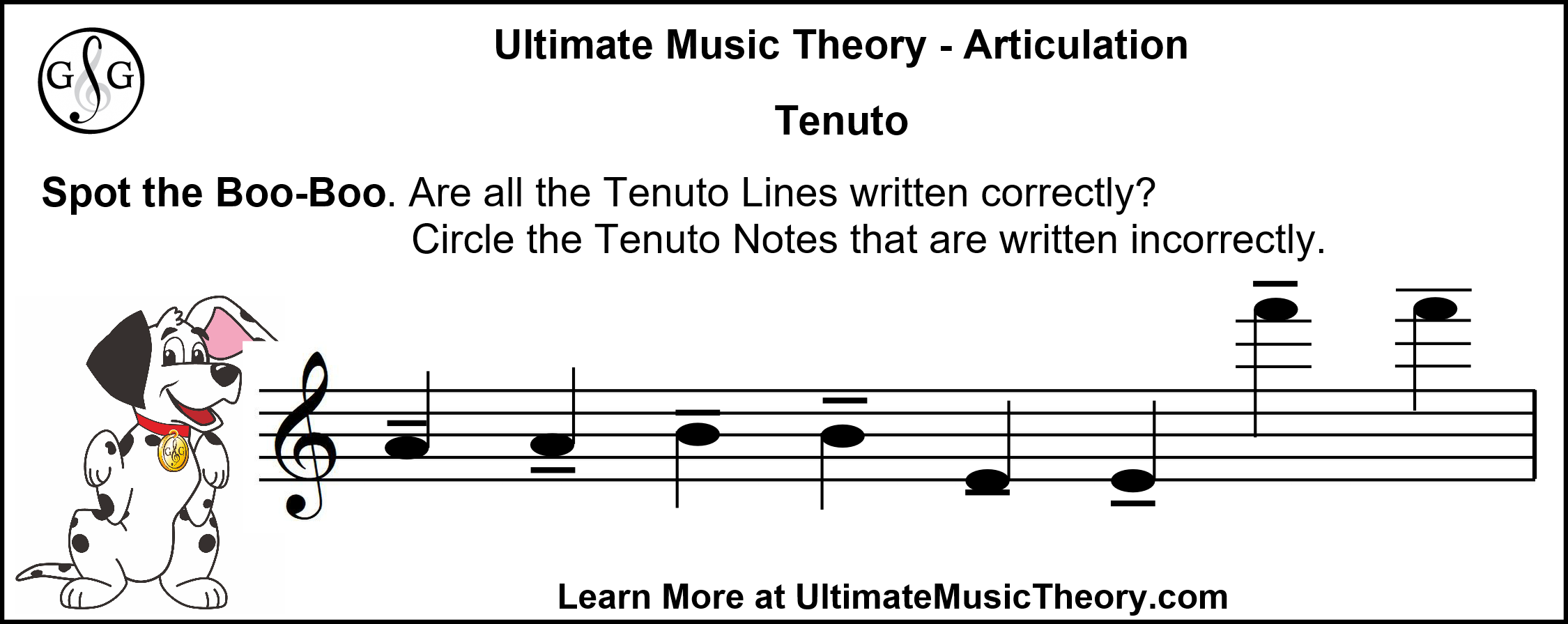
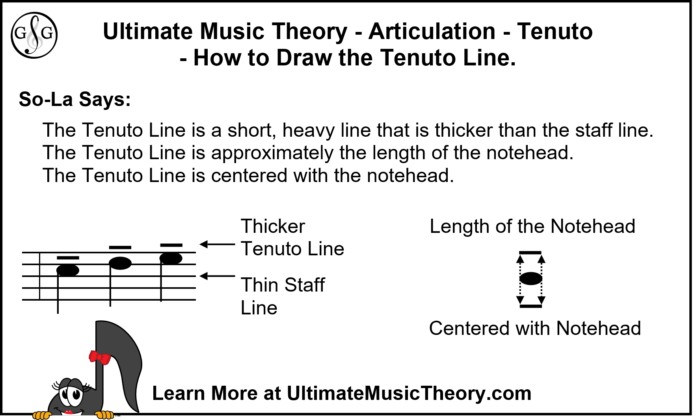
Articulation - Tenuto - How to Draw the Line
The Articulation Sign or Mark that tells us to play a note "held, sustained" is a small line. I tell my Students that we often see a Tenuto Line after a bunch of Staccato Dots. It's like the Composer took their pencil to write a Staccato Dot and said "OOPS - I want this to NOT be staccato", so they scratch out that dot and it ends up looking like a line.
Staccato Dot = Separated, Detached. Tenuto Line = NOT Separated or Detached!
To draw that Tenuto Line, their are 3 rules:
- The line should be a wee bit heavier than the staff line. (Heavier = thicker or darker)
- The line should be the same approximate length of the notehead. (Not too long, not too short)
- The line is centered with the notehead (not the stem).
I challenge my students to really try their best to draw these lines. If I know that they CAN draw it properly, then I will encourage and expect them to do just that. If I know that they do not yet have the hand coordination or the motor skills to draw it 100% correctly, then I encourage and expect them to do their best. (Heads up Teachers, when I am marking your Exams from the Ultimate Music Theory Certification Course, I will encourage and expect you to write correctly. Why? Because I know that you CAN do it.)
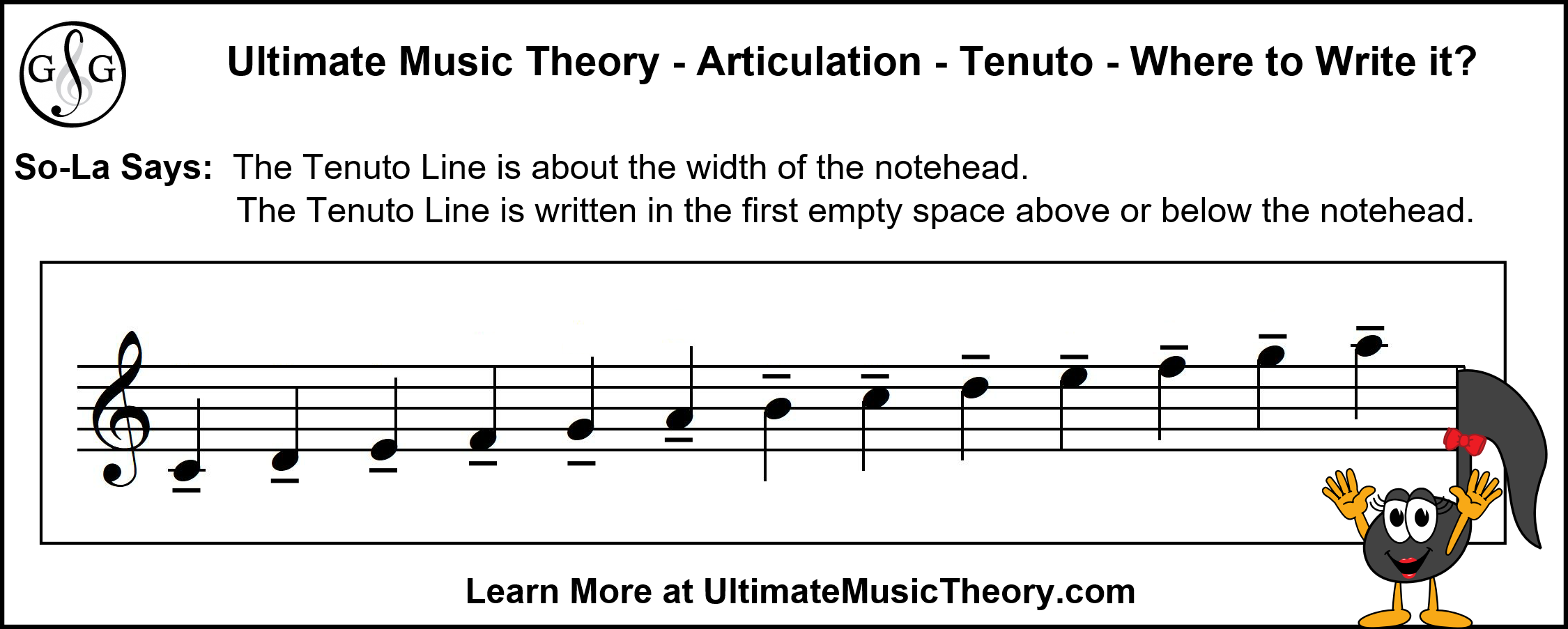
Now that we know how to write the Tenuto Line, how can we clarify to our students how to PLAY a note that has a Tenuto Line (other then, it is not staccato)?
The Norton Manual of Music Notation states that notes involved are to be played smoothly, at full value, but not slurred.
The Essential Dictionary of Music Notation states that a Tenuto indicates that a note or chord is to be held for its full value (durational articulation), or the intent may be to apply a slight stress (articulation of force).
This definition continues to state that, However it is interpreted, the tenuto is meant to ensure that a note or chord will be given a certain amount of attention.
Makes sense! Tenuto means held, sustained. A note with a Tenuto Line is not shorter than the value. It is not longer than the value. It is simply playing the actual value of the note.
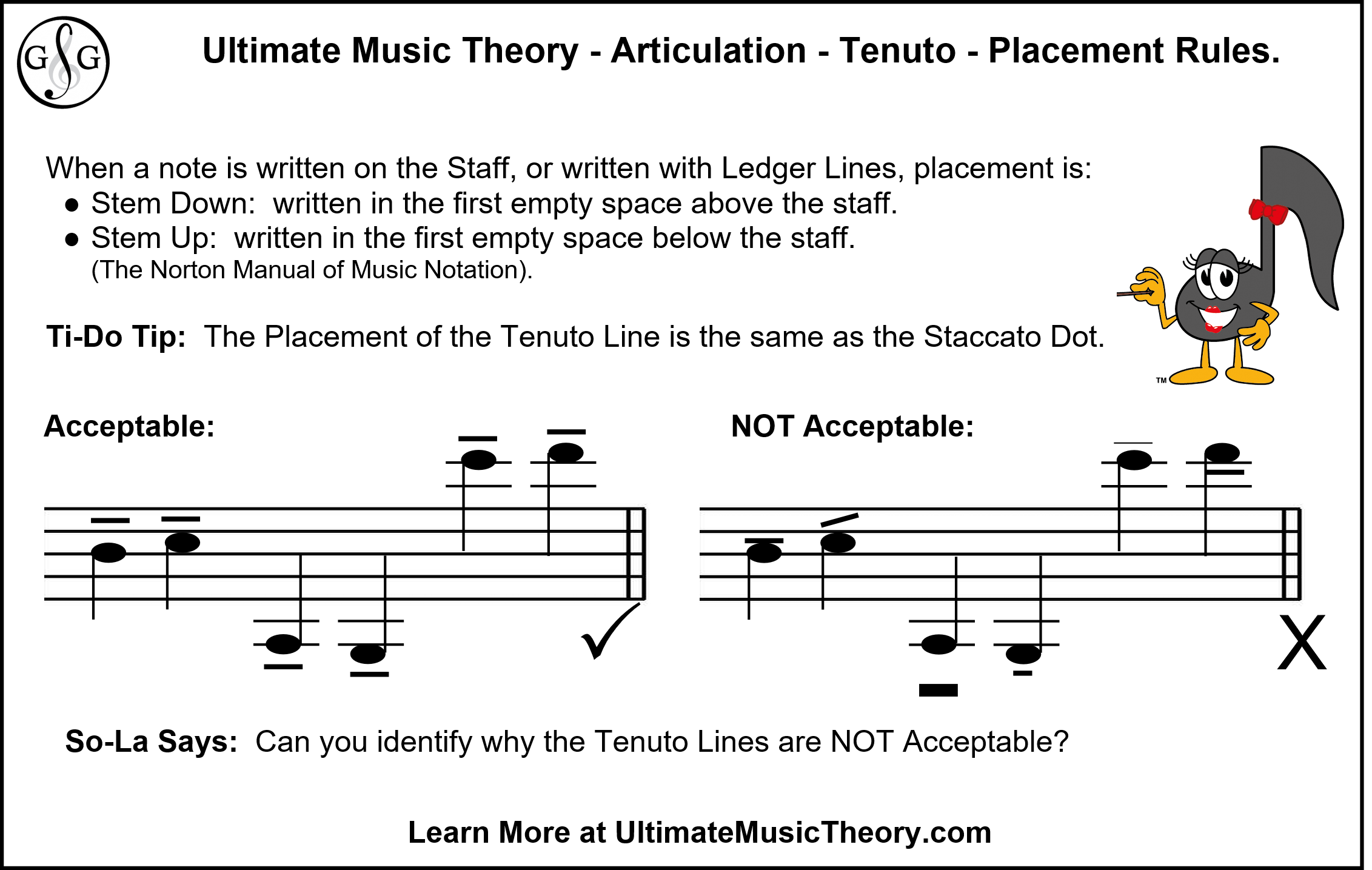
Top 5 Reasons Why a Tenuto Line is Considered Not Acceptable:
Here are my top 5 reasons why I would circle a Tenuto Line and mark it as incorrect:
- The Tenuto Line is not written in an empty space. Remember, if part of the notehead or part of the stem is in the space, the space is not empty!
- The Tenuto Line is written way too long or way too short. Remember, the Tenuto Line is the same distance across as the notehead.
- The Tenuto Line is not written "straight across". Remember to use a ruler to keep that line straight - just like the straight staff lines.
- The Tenuto Line is written way too thin or way too thick. Remember that it is just a tiny bit thicker than a staff line or a ledger line. (I tell my students to draw it once, then trace over it one more time in order to make it a wee bit darker.)
- When using Ledger Lines, the Tenuto Line is written way too close or way too far away from the notehead. Remember to write it so that there is a small empty area between the top or bottom of the notehead and the Tenuto Line.
One thing that I do love about the Tenuto Line is that the rules for writing it are basically the same as for writing the Staccato Dot. So, when that Composer decides "no more staccato", the line is written using the same placement rules as they used when adding the Staccato Dots!
With all of that in mind, here are the Answers to our Spot the Boo-Boo Challenge!
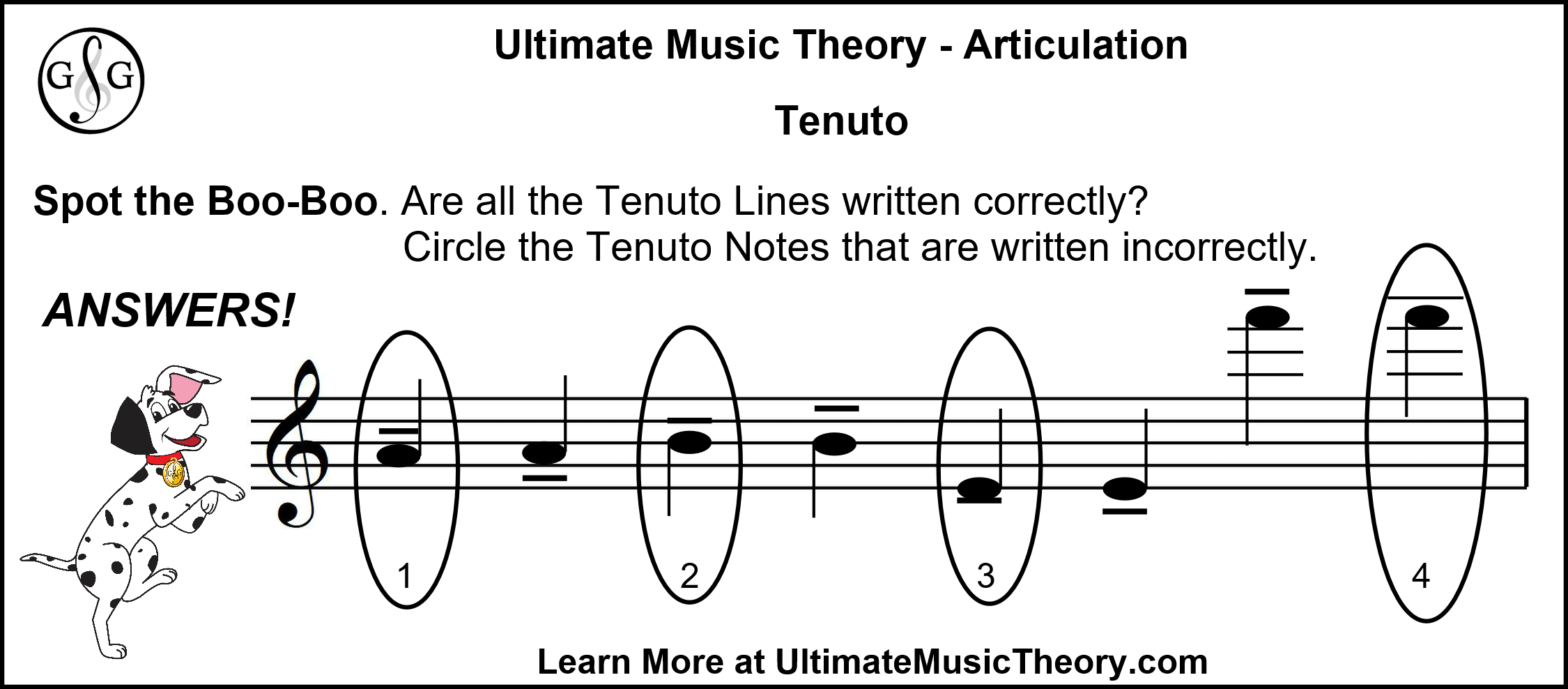
Articulation - Tenuto - Spot the Boo-Boo Answers
Did you catch all 4 of the Boo-Boos? Here are the reasons why those placements are incorrect:
- The Tenuto Line must be written in the first empty space either above or below the notehead. When the stem is up, the space above the notehead is not empty - there is a stem in it!
- The Tenuto Line must be written in a space (and not on top of the staff line).
- The Tenuto Line must not touch the notehead. This can be tricky for notes written in spaces above or below the staff/ledger lines.
- The Tenuto Line is not the same length as a ledger line. It is not the same "thickness" as a ledger line either.
Did you notice the BONUS BOO-BOO in #4? If you don't see the other Boo-Boo, please read the Blog Music Note Stem Length.
Articulation - Tenuto - Need Worksheets?
Have you checked out the Ultimate Music Theory Membership yet? As part of your Membership, you will be able to print two corresponding Worksheets for this Blog.
The first Worksheet is Articulation - Add the Stems and the Tenuto Lines. The second Worksheet is Articulation - Ledger Lines, Stems and Tenuto Lines. Both Worksheets have Answer Sheets to make your marking super easy!
And remember, the only way to access these Worksheets is to have an Ultimate Music Teachers Membership.
Ultimate Music Teachers Membership
♪ LEARN ♪ PLAN ♪ TEACH ♪ GROW
The One & ONLY Ultimate Music Teachers Membership
To Become A UMT PRO!
Your Success Path Starts Here - Go To TeachUMT.com Today!
Keep on Learning... With a Smile and a Song!
Shelagh McKibbon-U'Ren


